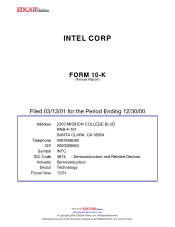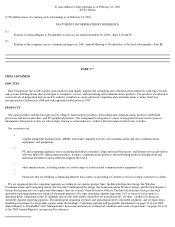Intel 2000 Annual Report Download - page 6
Download and view the complete annual report
Please find page 6 of the 2000 Intel annual report below. You can navigate through the pages in the report by either clicking on the pages listed below, or by using the keyword search tool below to find specific information within the annual report.
To help computer makers accelerate their products' time-to-market, we design, manufacture and sell chipsets for each computing market
segment. In 2000, we introduced the Intel® 820E, 815 and 815E chipsets for Pentium III processor-based PCs, each with a new input/output
controller hub delivering greater system performance and flexibility. We also introduced the Intel® 815EM mobile chipset with integrated
graphics for mobile PCs based on the Pentium III and Celeron processors, and the Intel® 850 chipset supporting the Pentium 4 processor.
In January 2001, we introduced the Intel® 810E2 chipset for Celeron processors, which enables PC makers to provide faster disk drive
performance, more Universal Serial Bus (USB) ports and surround sound audio in systems priced at less than $1,000.
For workstation and server makers, we provide the Intel® 840 chipset, which supports the Pentium III Xeon processor to enhance system
features and capabilities allowing greater texturing, more fluid movements, and better display output in demanding workstations and servers.
We also offer the Profusion™ chipset, supporting up to eight Pentium III Xeon processors, designed to help OEM customers build advanced
multiprocessing servers.
4
Intel's customers demand alternatives in the area of memory architecture. In response to that demand Intel chipsets currently support Rambus
Dynamic Random Access Memory (RDRAM) and Synchronous DRAM (SDRAM). In the future Intel expects to add support for Double Data
Rate DRAM (DDR) to its product line. Intel has adopted RDRAM as the primary memory solution for its flagship desktop Pentium 4
processors and is actively working with the industry to promote RDRAM as the highest performance desktop memory solution.
Board-level products. While many of our OEM customers use our microprocessors as components in designing their own computer
products, some use board-level products that we design and build as basic building blocks in their products. OEMs may buy at this level of
integration to accelerate their time-to-market and direct their own investments to other areas of their product lines. We provide board-level
products to give our OEM customers flexibility, and board-level products based on our microprocessors are available for most computing
market segments.
Sales and gross margin. During 2000 and 1999, sales of microprocessors and related board-
level products, including chipsets, based on the
P6 micro-architecture comprised a substantial majority of our consolidated net revenues and gross margin. For 1998, these products
represented a majority of our consolidated net revenues and a substantial majority of gross margin. Sales of Pentium® family processors,
including Pentium processors with MMX™ technology were rapidly declining but still a significant portion of our revenues and gross margin
for 1998. In 2000, we initiated a program to replace motherboards that had a defective memory translator hub component that enabled SDRAM
to work with the Intel® 820 chipset. The total impact on gross margin for this program was approximately $253 million.
Wireless Communications and Computing Group
The Wireless Communications and Computing Group (WCCG) provides a variety of component-level hardware and software used in digital
cellular communications products and other applications using both low-power processing and flash memory. WCCG products support
handheld devices such as mobile phones, two-way pagers and personal digital assistants.
Flash memory. Flash memory is a specialized type of memory component used to store user data and program code; it retains this
information even when the power is off. Our flash memory is used predominantly in mobile phones, but is also found in other products
including MP3 music players, handheld PC organizers, handheld voice recorders and digital answering machines, in addition to industrial
products such as network routers and communications systems. In May 2000, we reached a significant milestone, shipping our billionth flash
memory chip since the product's introduction in 1988.
In April 2000, we announced the Intel® 0.18-micron Advanced+ Boot Block Flash Memory, our first flash memory product using our 0.18-
micron manufacturing process. This fourth-generation Boot Block memory product includes next-generation advanced security features that
minimize the risk of cloning and other types of fraud in digital mobile phones and Internet appliances. In October 2000, we announced the
Intel® 1.8 Volt Wireless Flash Memory, with four times higher performance than previous flash products and low-voltage features that allow
Internet-enabled cellular phones to save up to 60% of their energy, thus extending battery life.
Embedded solutions for handheld devices. In August 2000, we introduced the Intel® XScale™ micro-
architecture, a new chip architecture
designed to be used in a wide variety of advanced handheld devices, wireless Internet devices and networking infrastructure applications.
Building on Intel® StrongARM technology which we license from ARM, Ltd., the Intel XScale micro-architecture offers low-power operation
(as low as 1/10,000th of a watt) and fast clock speeds (approaching 1 GHz), supplying the needs of a diverse set of Internet client devices as
well as networking and storage equipment. The low-power capabilities of the Intel XScale micro-architecture are enhanced with our
5



















